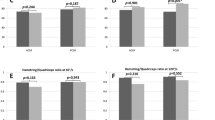Abstract
Twenty-three patients who had undergone unilateral patellectomy were tested using the Cybex II isokinetic dynamometer 9 years postoperatively. The results were compared with the performance of the uninvolved joint. There was a good correlation between loss of the quadriceps muscle function and loss of the hamstrings muscle function at 60 deg/s (R=0.7,P<0.001). Patients who showed a loss of quadriceps function of less than 40% also maintained good hamstrings function. A good or excellent functional result could be expected in these patients. If the loss of quadriceps function was more than 40%, a proportional loss of flexion torque was seen, indicating a functional impairment of the knee joint muscles not solely attributable to the loss of the lever arm. Furthermore, all patients with a loss of peak flexion torque of more than 30% showed an unsatisfactory clinical result. The evaluation of the hamstrings muscles by measuring the peak flexion moment at 60 deg/s can therefore be used as a preoperative assessment and as a guideline for rehabilitation after patellectomy.
Similar content being viewed by others
References
Blatter G, Jackson RW, Bayne O, Magerl F (1987) Patellectomy as a salvage operation. Orthopäde 16: 310–316
Cantin S, Laroche C, Lavallee P, Lessard JM (1993) Patellectomy: results of a long-term follow-up. Can J Surg 36: 461–463
Davies GJ (1987) A compendium of isokinetics in clinical usage, 3rd edn. S & S Publishers, Wisconsin, pp 1–17
Einola S, Aho AJ, Kallio P (1976) Patellectomy after fracture: long-term follow-up results with special reference to functional disability. Acta Orthop Scand 47: 441–447
Jakobsen J, Christensen KS, Rasmussen OS (1985) Patellectomy — a 20-year follow-up. Acta Orthop Scand 56: 430–432
Kaufer H (1971) Mechanical function of the patella. J Bone Joint Surg [Am] 53: 1551–1560
Lennox IA, Cobb AG, Knowles J, Bentley G (1994) Knee function after patellectomy. A 12-to 48-year follow-up. J Bone Joint Surg [Br] 76: 485–487
Nisell R, Ericson M (1992) Patellar forces during isokinetic knee extension. Clin Biomech 7: 104–108
Peeples RE, Margo MK (1978) Function after patellectomy. Clin Orthop 132: 180–186
Sutton FS, Thompson CH, Lipke J, Kettelkamp DB (1976) The effect of patellectomy on knee function. J Bone Joint Surg [Am] 58: 537–540
Watkins MP, Harris BA, Wender S, Zarins B, Rowe CR (1983) Effect of patellectomy on the function of the quadriceps and hamstrings. J Bone Joint Surg [Am] 65: 390–395
Wendt PP, Johnson RP (1985) A study of quadriceps excurison, torque, and the effect of patellectomy on cadaver knees. J Bone Joint Surg [Am] 67: 726–732
Ziran BH, Goodfellow DB, Deluca LS, Heiple KG (1994) Knee function after patellectomy and cruciform repair of the extensor mechanism. Clin Orthop 302: 138–146
Author information
Authors and Affiliations
Rights and permissions
About this article
Cite this article
Kuster, M., Blatter, G. Knee joint muscle function after patellectomy: how important are the hamstrings?. Knee Surg, Sports traumatol, Arthroscopy 4, 160–163 (1996). https://doi.org/10.1007/BF01577410
Received:
Accepted:
Issue Date:
DOI: https://doi.org/10.1007/BF01577410



